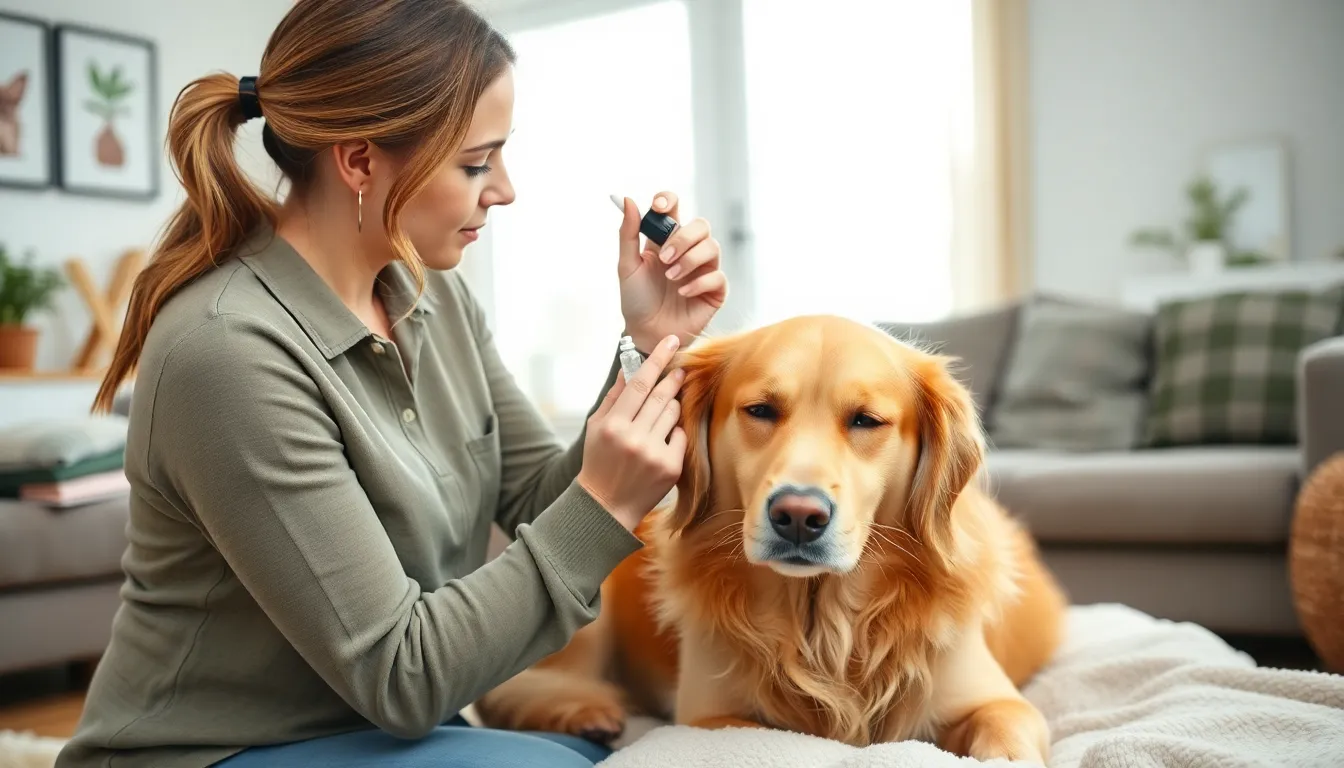Every dog owner knows that keeping their furry friend clean is part of the job description. But when it comes to cleaning those floppy ears, many might feel like they’re gearing up for a wrestling match. Fear not! With a little guidance and a sprinkle of humor, cleaning your dog’s ears at home can be a breeze.
Table of Contents
ToggleImportance Of Cleaning Dogs Ears
Cleaning dogs’ ears prevents infections. Earwax buildup can create a breeding ground for bacteria and yeast. Regular cleaning aids in identifying any issues early, such as redness or bad odor.
Ear infections rank among the most common health problems in dogs. Vets note that dogs with floppy ears or allergies are more susceptible. Maintaining ear hygiene significantly reduces the risk of these infections.
A clean ear enhances a dog’s overall health. It contributes to comfort and well-being. Dogs free from ear issues often exhibit improved behavior and quality of life.
A proper ear cleaning routine also supports hearing. Dogs rely on their sense of hearing for communication and navigation. When ears are clogged, this vital sense might diminish.
Preventing ear problems saves time and costs related to vet visits. Early detection and regular maintenance often lead to fewer health complications. Investing time in ear care at home leads to healthier, more active dogs.
Fostering a habit of regular ear cleaning can strengthen the bond between dog and owner. Making it a positive experience encourages cooperation during future cleanings. Hence, this routine is not just about hygiene; it’s part of responsible pet ownership.
Supplies Needed For Cleaning Dogs Ears At Home

Gathering the right supplies simplifies the process of cleaning dogs’ ears at home. Focusing on quality and effectiveness ensures a safe experience for pets.
Ear Cleaner Solutions
Using an appropriate ear cleaner solution minimizes the risk of irritation. Look for vet-recommended products that contain soothing ingredients, such as aloe or witch hazel. Many dog owners prefer solutions specifically designed to remove wax and debris without harmful chemicals. Opt for easy-to-apply solutions, often available in dropper bottles, which help control the amount dispensed. Regular use maintains ear hygiene and prevents the buildup that can lead to infections.
Cotton Balls And Swabs
Selecting cotton balls and swabs provides effective tools for ear cleaning. Cotton balls offer a gentle way to wipe out accumulated wax, and their size makes them easy to use. Swabs reach deeper into the ear canal and can help remove stubborn debris. Choose dog-safe, non-toxic swabs to avoid injury. Dispose of used materials properly after each cleaning session to maintain a clean environment. Regularly incorporating these tools into a cleaning routine promotes overall ear health.
Step-By-Step Guide To Cleaning Dogs Ears
Cleaning a dog’s ears at home requires preparation and a clear process. Following simple steps leads to effective results, ensuring the dog’s ears remain healthy.
Preparing Your Dog
Ensure the dog is calm before starting the cleaning process. Choose a quiet space free from distractions to create a relaxed environment. Using treats or praise can encourage cooperation. Inspect the dog’s ears for any signs of redness, swelling, or discharge. If any abnormalities are present, consult a veterinarian before proceeding. Gather all necessary supplies, including a quality vet-recommended ear cleaner, cotton balls, and dog-safe swabs. Having everything on hand simplifies the process and keeps the dog from becoming anxious.
The Cleaning Process
Start by applying a small amount of ear cleaner into the ear canal. Gently massage the base of the ear for about 20 to 30 seconds, which helps loosen wax and debris. Wipe away any excess cleaner and debris using a cotton ball. Avoid inserting anything deep into the ear canal, as this could cause injury. Utilize dog-safe swabs for deeper cleaning, if necessary. Finish by praising the dog, ensuring a positive experience. Regularly cleaning the ears every 1 to 4 weeks keeps them healthy and prevents infections.
Signs Of Ear Problems In Dogs
Ear problems in dogs often manifest through specific signs that owners should monitor closely. Frequent scratching at the ears indicates irritation. Head shaking or tilting suggests discomfort within the ear canal. Additionally, a foul odor emanating from the ears can signal an infection.
Redness or swelling around the ear flaps often accompanies other symptoms. Some dogs may exhibit increased sensitivity when touching the ears, indicating potential pain. Discharge, whether brown, yellow, or bloody, raises concerns about underlying issues.
Behavioral changes, such as increased irritability or lethargy, may also point to ear problems. Owners might notice their dogs being less active or displaying signs of distress. If a dog appears to have reduced hearing or seems unresponsive to sound, it’s crucial to investigate further.
Monitoring the dog’s overall hygiene can help identify ear issues early. Noticing a change in grooming habits, like neglecting ear cleaning, also serves as a red flag. Regular checks can help catch problems before they worsen, ensuring a healthier and happier pet.
Ultimately, recognizing these signs allows for timely intervention and treatment. When symptoms persist, consulting a veterinarian ensures that proper care is provided, preventing further complications. Regular ear maintenance combined with vigilant observation promotes the dog’s ear health.
Best Practices For Maintaining Ear Health
Regular ear cleaning helps maintain your dog’s ear health and prevents infections. Owners should establish a routine of cleaning every 1 to 4 weeks, depending on the dog’s specific needs. For instance, breeds with floppy ears may require more frequent cleaning due to increased moisture and wax buildup.
Using vet-recommended ear cleaner solutions is essential. Quality cleaners often contain soothing ingredients like aloe or witch hazel that minimize irritation during the cleaning process. Cotton balls serve well for gentle wiping while dog-safe swabs can effectively reach deeper into the ear canal.
Inspection before cleaning is important. Look for signs of redness, swelling, or discharge that may indicate an underlying issue. Monitoring your pet’s ears allows for timely intervention if necessary, as any signs of trouble may require a visit to the veterinarian.
Creating a calm environment can enhance the experience for both owner and dog. Starting in a distraction-free space helps the dog remain relaxed during the cleaning process. Positive reinforcement, such as praise or treats, encourages cooperation from your pet.
Discard used cleaning materials properly to maintain a hygienic environment. Establishing a regular cleaning routine can foster a stronger bond between the dog and its owner, making ear care a collaborative experience.
Observing for behavioral changes is crucial as well. If your dog exhibits increased irritability, excessive scratching, or head shaking, these may signal ear issues. By remaining vigilant, owners can help ensure their dogs enjoy healthy, comfortable ears.
Cleaning a dog’s ears at home can be a rewarding experience that strengthens the bond between pet and owner. By following the right techniques and maintaining a regular cleaning schedule, owners can effectively prevent ear infections and promote overall ear health.
It’s essential to remain observant and responsive to any changes in a dog’s behavior or ear condition. This vigilance not only aids in early detection of potential issues but also ensures a happier and healthier life for the pet.
With the right tools and a calm approach, ear cleaning can transform from a daunting task into a simple routine that benefits both the dog and its owner in the long run.


